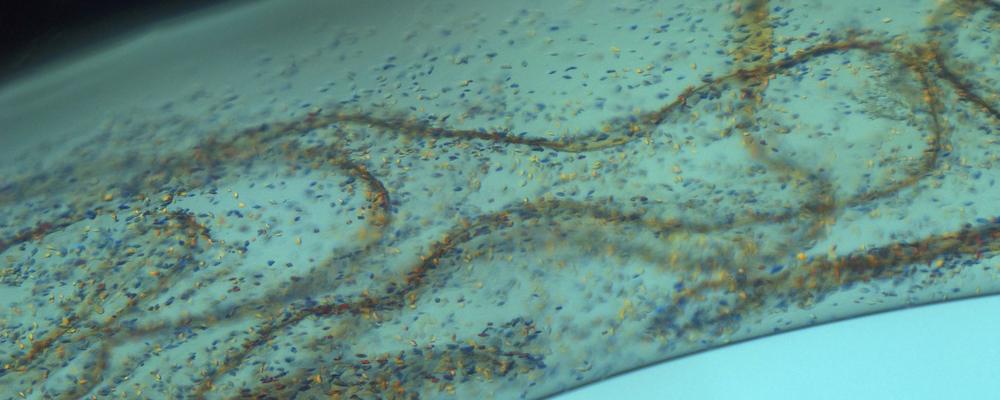
Biochemistry and Structural Biology
The research groups within Biochemistry and Structural Biology study the structure, function and dynamics of proteins, as well as cellular structures. The research teams constitute a world-leading research environment and make a strong contribution to the University of Gothenburg’s top ranking within Life Science.
Research areas
Our major focus areas are
- Development of new methods to determine the detailed structures of biomolecules
- Dynamic protein complexes
- Eukaryotic flagella
- Intrinsically disordered proteins
- Membrane proteins
- Pharmaceutical discovery
- Photo activated systems
Our research groups have expertise and use techniques within a range of biophysical methods such as X-ray crystallography, NMR, EPR, cryo-electron tomography and computational modelling. Time resolved structural studies is a key activity in several groups.
Research goals
Our research aims
- To better understand the structure-function-dynamics relationship of the cellular machinery
- To develop new and innovative methods for production and characterization of biomolecules
- To identify novel therapeutic drugs combatting, among others, cancer and antibiotic resistance.
Collaborations and research grants
Our researchers have extensive national and international networks. Locally, we have joint projects together with Chalmers University of Technology and Sahlgrenska Academy. We also collaborate with industry. We have, for instance, a joint doctoral student together with AstraZeneca.
Several groups conduct experiments at research infrastructures around the world. We have very tight links with the Swedish synchrotron facility MAX IV and work closely with the Swedish NMR Centre as well as with the cryo-EM Swedish National Facility.
Our research groups are highly successful in attracting external financing and have been awarded several prestigious research grants, including two European Research Council grants, three Wallenberg Fellow/Scholar/Molecular Medicine grants and a Distinguished Professor grant from the Swedish Research Council.
Gisela Brändén, Professor of Membrane Protein Structure, Function and Dynamics
Development of methods for time-resolved structural studies using synchrotron and XFEL radiation, applied to study membrane-bound energy converting enzymes of the cell. Structure-based drug design to develop novel antibiotics.

Björn Burmann, Professor of Biophysics
The Burmann group investigates macromolecular protein machines by high-resolution Nuclear Magnetic Resonance (NMR) to decipher dynamical and structural changes underlying essential cellular functions.
Leif Eriksson, Professor of Physical Chemistry
Computer based modeling of protein structures, enzymatic mechanisms, protein-protein interactions and design of new pharmaceuticals, primarily focusing on cancer and antibiotics.
Örjan Hansson, Senior Lecturer in Molecular Biophysics
The research involves studies of electron-transfer reactions in photosynthesis and of copper-containing proteins using EPR spectroscopy. In addition, we are doing research in educational science, in particular how science centers can be used in the education of science teachers.
Kristina Hedfalk, Professor of Biochemistry
Increased knowledge of the structure and function of integral membrane proteins, key molecules in all cells, requires protein design and stable production in a suitable host.
Johanna Höög, Professor of Cell Biology
Johanna Höög's group focuses on cellular electron microscopy, especially cryo-electron tomography. The research focus is on how eukaryotic flagella are constructed, especially human sperm tails.
Gergely Katona, Professor of Biochemistry
Gergely Katona's group investigates the terahertz dynamics in biomolecules. The group is particularly interested in energy/information transmission and storage mediated by phonons in biological environments.

Göran Karlsson, Senior Lecturer

Julia Morud Lekholm, Associate Senior Lecturer in Molecular Neurobiology
Julia Morud Lekholm studies how information flow in neuronal networks is controlled by ion channels, by performing in vivo studies in the nematode C. elegans and biochemical and biophysical techniques for dynamical protein studies.
Read more about Julia Morud Lekholm
Richard Neutze, Professor
Richard Neutze's research group aims to observe structural changes in membrane proteins using time-resolved X-ray crystallography. The group uses X-rays produced at synchrotron radiation sources or X-ray free electron lasers in these studies.
Vladislav Orekhov, Professor of Nuclear Magnetic Resonance Spectroscopy
Developing and applying NMR methodology for structural biology. We integrate novel experiments, signal processing algorithms, and artificial intelligence for removing barriers in biomolecular NMR studies.
Our research in Biochemistry and Systematic Biology contributes to sustainable development in many different ways. Amongst others, we work with
Zero hunger
Phytochromes are light sensitive proteins in plants and bacteria. We study their structure and thereby their detailed function. In the future, our research may contribute to the development of plants with specific characteristics that can be used to make agriculture more efficient.
Good health and well-being
Several projects investigate the molecular mechanisms behind different cancers, bacterial resistance and neurodegenerative diseases such as dementia. We use structure-based drug design to find new candidates for pharmaceutical drugs. In addition, a predictive models of biomolecules are developed to assist diagnostics, reveal the causes of diseases and to assists drug development. Several of the proteins studied are common drug targets.
Gender equality
Fertility problems are commonly associated with the reproductive health of women. Our research on the structure of sperm tails gives a better and broader understanding of the problem of infertility.
Clean Water and sanitation
One of our goals is to better understand the transcription of virulence genes of the bacterium Vibrio cholerae in order to be able to more efficiently get rid of it in drinking water. Another of our research targets is aquaporins, proteins that act as water filters in the cells. These can potentially be isolated and used in water filtration devices.
Affordable and clean energy
Artificial biological systems could potentially reduce the energy requirements of industry in the future. Our studies of photosynthesis contribute to a basic understanding of efficient energy production.
Industry, innovations and infrastructure
Examples from our research within drug design have been commercialised and may lead to future pharmaceuticals.






